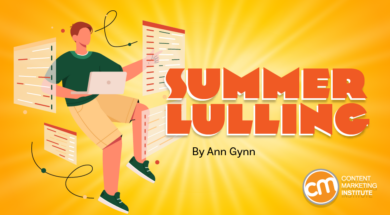
Everybody should take their vacation time.
Studies show stepping away from work can lower stress, lessen the risk of heart disease, and give more motivation to achieve goals.
But when people follow that advice – often in larger numbers in the summer and at the end of the year – content marketers struggle to find sources in the office, approvers to review their content, etc.
Instead of letting that frustrate you, why not use the forced downtime productively?
I’m not advocating that you push yourself and your team out of the relaxed zone and into the extreme sports zone. But you can work on useful things that don’t necessarily require much brain power (or close supervision) but fall off the priority list during busier times.
The results will inform and improve your content marketing strategy year-round. Try some of these ideas.
1. Dig into your analytics manually
Sure, you can pull a lot of automated analytics reports about your content. But I bet you don’t get every number you want in the package or format you want.
For example, I have a client who distributes an email newsletter through a marketing hub provider. The platform’s analytics list open and click-through rates alongside each issue title. But there’s no option to create a report with the results from every issue in a single spreadsheet.
To compare results or identify trends, I’d have to manually enter the data into a spreadsheet. It’s a time-sucking task that I never get around to doing.
I hired some help this summer and put that task on his to-do list. When he finishes, I’ll have a big-picture view I can use to update the editorial strategy.
Here’s another example: Dig into your click-to-tweet performance. Do you know whether placement (beginning, middle, or end of the article) affects the number of clicks? What about who’s tagged in the tweet?
The point is to identify available data – quantitative or qualitative – that requires (or benefits from) manual work to make it more helpful to your content marketing program.
Identify available data that needs manual work to make it useful to your #ContentMarketing. Put interns or extra resources to work on that, says @AnnGynn via @CMIContent. Click To Tweet2. Listen to and watch your content
Ensuring content accessibility is a smart marketing strategy – and the right thing to do.
You probably write alt text for your images, use Pascal case for your hashtags (#SummerLull, not #summerlull), and provide captions for your videos. (If not, start there.)
But have you ever experienced your content as people who have a vision or hearing impairment might? Take the time to do it now.
Have you experienced your #content the way people who have a vision or hearing impairment might? @AnnGynn suggests you try it via @CMIContent. Click To TweetDownload text-to-speech software and feed your most popular written content assets into it. (Microsoft already embeds text-to-speech software in Word.)
How is the listening experience? Are there commonly used acronyms, terms, or phrases that don’t translate well to the ear? Are there other glitches you could remedy by editing the content or avoiding them in the future?
Get another perspective on your vocal content. Download speech-to-text software and/or read the results (i.e., video captions and transcripts) word for word. Are the spoken words easily translatable into text? Do the terms you use have multiple spellings that could cause confusion? How is background sound translated or disclosed in the text?
Review a few pieces of content in each format, then note and share potential trouble spots with your content creators. That way, they can avoid them in the future.
3. Create almost-finished evergreen or predictable content
Get a head start now on creating some content pieces you know you’ll need in the next six months or so.
Identify planned content that doesn’t involve many other people (scheduling time with them can be hard in peak vacation times). Content pieces that are updates or refreshes of things you wrote last year are good candidates, whether they’re articles, infographics, videos, e-books, or other types.
Then get to work. Note what might need to be reviewed or updated closer to the publishing date.
During slow periods, get a head start on creating content pieces you know you’ll need some time in the next six months, says @AnnGynn via @CMIContent. Click To Tweet4. Transform top-performing content into other formats
Many content marketing programs focus on a single content type for their primary channel (think articles on their website or videos on their YouTube channel). But you can add something different to your mix without much effort.
Convert some of the highest-performing content on your primary channel into new formats or try publishing on lesser-used channels:
- Turn a how-to blog into a step-by-step infographic.
- Turn a video into a handful of images and publish a carousel on Instagram.
- Turn a webinar into an article.
Yes, these are content repurposing opportunities, but they’re also ways to discover new audience preferences for formats or distribution channels.
5. Add content accouterments
Maybe you’ve met your publishing deadlines by skipping small but important aspects of the content – timestamps, episode descriptions, captions, customized excerpts, meta descriptions, etc. Wait, you’d never do that, right?
OK, let’s say you’ve inherited a program where those elements weren’t understood or valued. Maybe your predecessor felt their absence wouldn’t affect content performance or even be noticed. After all, if someone fails to write a caption, the public-facing page doesn’t say “caption needed here” (unless something’s gone very wrong).
Even with the best intentions, you typically don’t have time to go back and finish adding those content accouterments. And if no one tracked which assets need these little content updates, the task takes even longer.
Try this approach to tackle the updates during your slow time:
- Create a checklist of must-have items for each content asset type.
- Decide on the period you want to address (last six months, a year, a set of years, etc.)
- Create an inventory of assets that need review.
- Review each item for all the necessary elements and check them off as completed.
Bonus: Onboard short-term staff for potential year-round work
I’ve heard companies say they resist bringing in interns or other temporary staff because, by the time they get up to speed, they’re almost ready to leave. Yet the investment can be worth it if you take a long view.
For example, the summer person in my business became my year-round proofreader. We worked together remotely after the summer ended. Proofreading didn’t require the same amount of time or formalized structure as all the summer work, so it fits his new schedule.
Ongoing tasks work well for retention. But look for other opportunities to keep former interns or temporary staff involved:
- Ask them to handle duties for someone who might be out on family leave.
- Ask them to cover gaps when team members resign or take new positions.
- Assign them to special projects that match their skills or knowledge.
Lean into the lull
Whether it’s a summer lull or a natural downtime in your business, you can take it easy and still be productive at work. Dig manually into your analytics, vet the accessibility of your content, convert existing assets into new formats, or come up with something mundane that’s always on your list but never seems to get done.
You’ll thank yourself for the help when times get busy, or your transformed content gets high marks from the audience.
What do you work on during slow times? Share your suggestions and plans in the comments.
HANDPICKED RELATED CONTENT:
Cover image by Joseph Kalinowski/Content Marketing Institute







